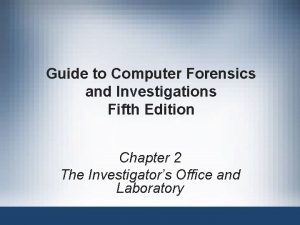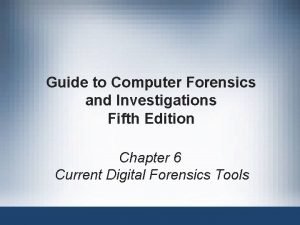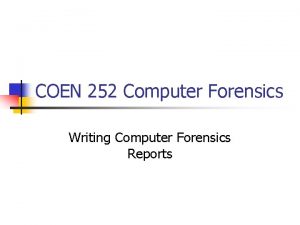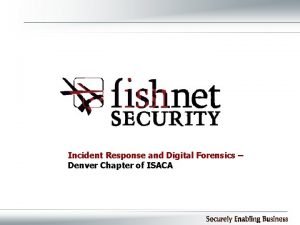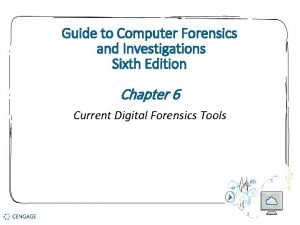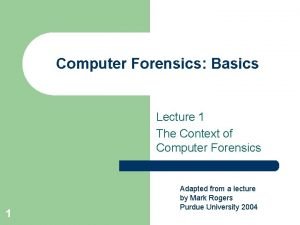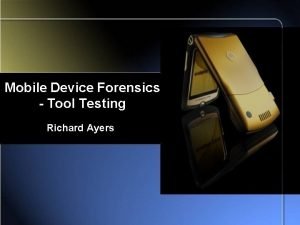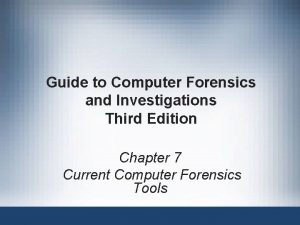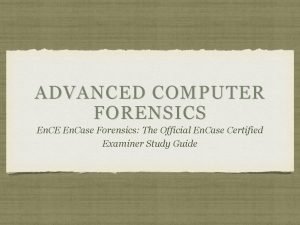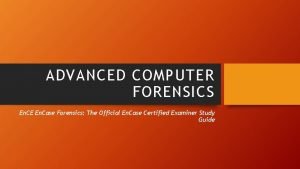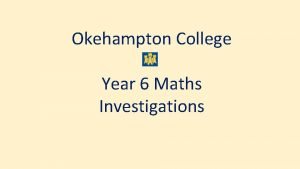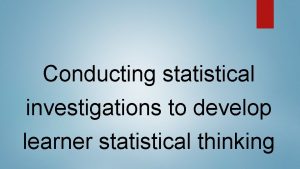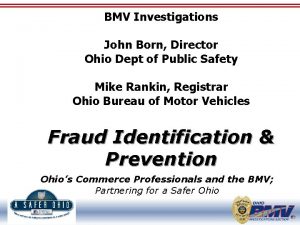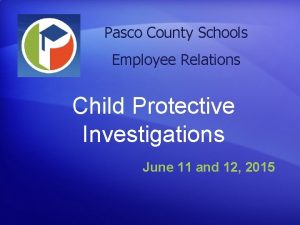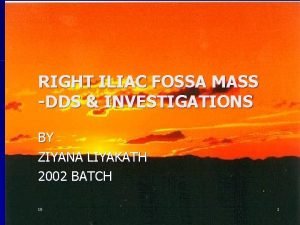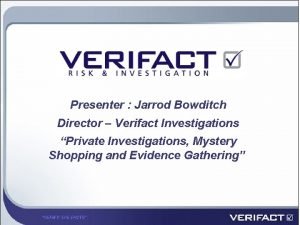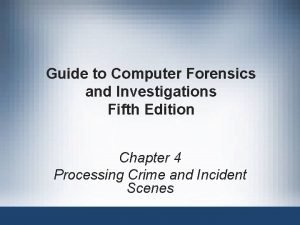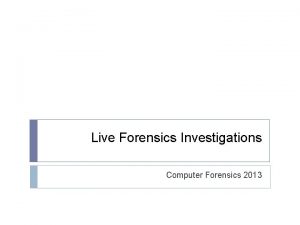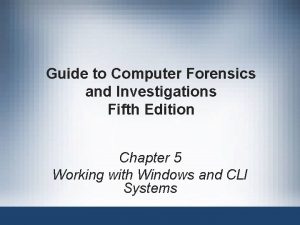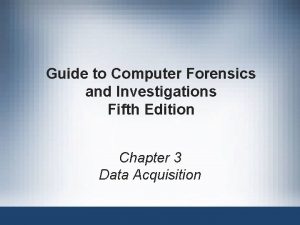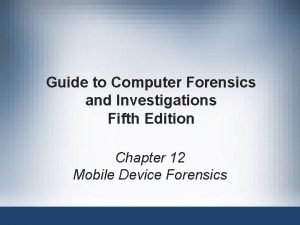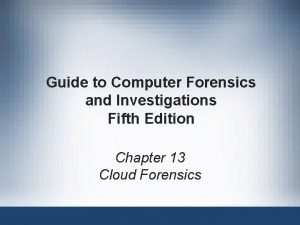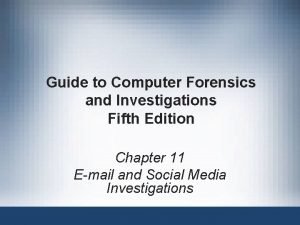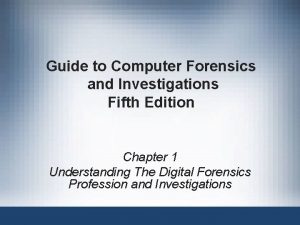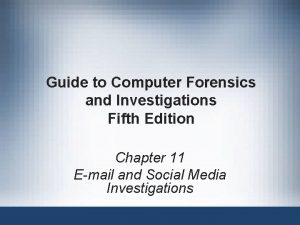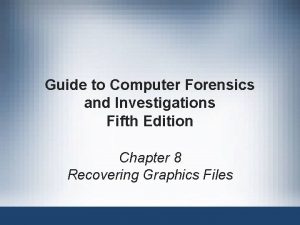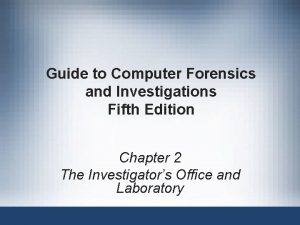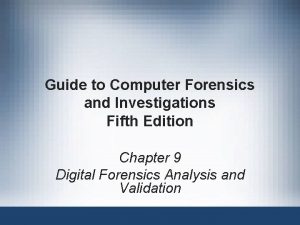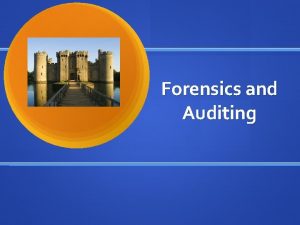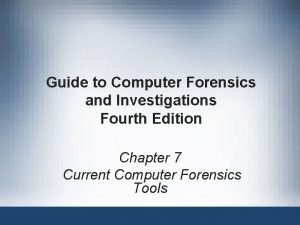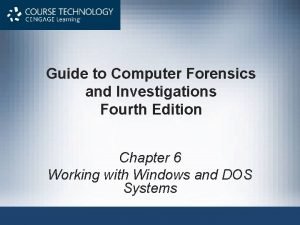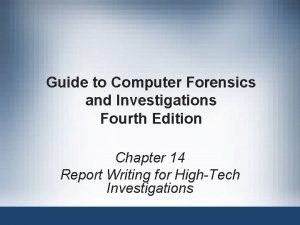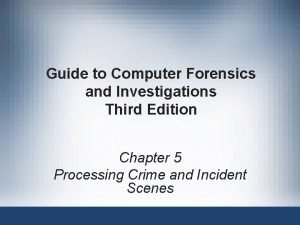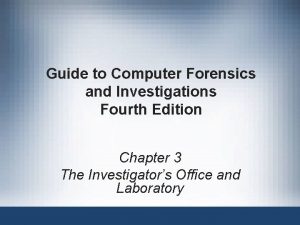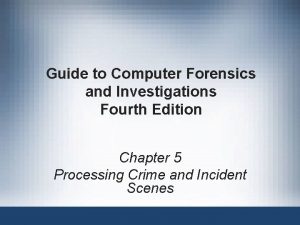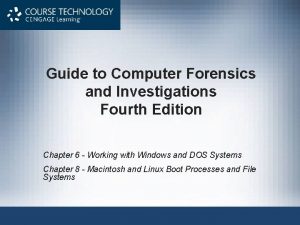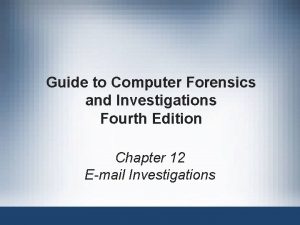Guide to Computer Forensics and Investigations Fifth Edition
















































- Slides: 48

Guide to Computer Forensics and Investigations Fifth Edition Chapter 2 The Investigator’s Office and Laboratory

Objectives • Describe certification requirements for digital forensics labs • List physical requirements for a digital forensics lab • Explain the criteria for selecting a basic forensic workstation • Describe components used to build a business case for developing a forensics lab Guide to Computer Forensics and Investigations, Fifth Edition © Cengage Learning 2015 2

Understanding Forensics Lab Certification Requirements • Digital forensics lab – Where you conduct your investigation – Store evidence – House your equipment, hardware, and software • American Society of Crime Laboratory Directors (ASCLD) offers guidelines for: – Managing a lab – Acquiring an official certification – Auditing lab functions and procedures Guide to Computer Forensics and Investigations, Fifth Edition © Cengage Learning 2015 3

Identifying Duties of the Lab Manager and Staff • Lab manager duties: – – – – Set up processes for managing cases Promote group consensus in decision making Maintain fiscal responsibility for lab needs Enforce ethical standards among lab staff members Plan updates for the lab Establish and promote quality-assurance processes Set reasonable production schedules Estimate how many cases an investigator can handle Guide to Computer Forensics and Investigations, Fifth Edition © Cengage Learning 2015 4

Identifying Duties of the Lab Manager and Staff • Lab manager duties (cont’d): – Estimate when to expect preliminary and final results – Create and monitor lab policies for staff – Provide a safe and secure workplace for staff and evidence • Staff member duties: – Knowledge and training: • Hardware and software • OS and file types • Deductive reasoning Guide to Computer Forensics and Investigations, Fifth Edition © Cengage Learning 2015 5

Identifying Duties of the Lab Manager and Staff • Staff member duties (cont’d): – Work is reviewed regularly by the lab manager • Check the ASCLD Web site for online manual and information Guide to Computer Forensics and Investigations, Fifth Edition © Cengage Learning 2015 6

Lab Budget Planning • Break costs down into daily, quarterly, and annual expenses • Use past investigation expenses to extrapolate expected future costs • Expenses for a lab include: – – Hardware Software Facility space Training personnel Guide to Computer Forensics and Investigations, Fifth Edition © Cengage Learning 2015 7

Lab Budget Planning • Estimate the number of computer cases your lab expects to examine – Identify types of computers you’re likely to examine • Take into account changes in technology • Use statistics to determine what kind of computer crimes are more likely to occur • Use this information to plan ahead your lab requirements and costs Guide to Computer Forensics and Investigations, Fifth Edition © Cengage Learning 2015 8

Lab Budget Planning • Check statistics from the Uniform Crime Report – For federal reports, see www. fbi. gov/ucr. htm • Identify crimes committed with specialized software • When setting up a lab for a private company, check: – Hardware and software inventory – Problems reported last year – Future developments in computing technology • Time management is a major issue when choosing software and hardware to purchase Guide to Computer Forensics and Investigations, Fifth Edition © Cengage Learning 2015 9

Lab Budget Planning Guide to Computer Forensics and Investigations, Fifth Edition © Cengage Learning 2015 10

Acquiring Certification and Training • Update your skills through appropriate training – Thoroughly research the requirements, cost, and acceptability in your area of employment • International Association of Computer Investigative Specialists (IACIS) – Created by police officers who wanted to formalize credentials in computing investigations – Candidates who complete the IACIS test are designated as a Certified Forensic Computer Examiner (CFCE) Guide to Computer Forensics and Investigations, Fifth Edition © Cengage Learning 2015 11

Acquiring Certification and Training • ISC² Certified Cyber Forensics Professional (CCFP) – Requires knowledge of • • • Digital forensics Malware analysis Incident response E-discovery Other disciplines related to cyber investigations Guide to Computer Forensics and Investigations, Fifth Edition © Cengage Learning 2015 12

Acquiring Certification and Training • High-Tech Crime Network (HTCN) – Certified Computer Crime Investigator, Basic and Advanced Level – Certified Computer Forensic Technician, Basic and Advanced Level • En. Case Certified Examiner (En. CE) Certification – Open to the public and private sectors – Is specific to use and mastery of En. Case forensics analysis – Candidates are required to have a licensed copy of En. Case Guide to Computer Forensics and Investigations, Fifth Edition © Cengage Learning 2015 13

Acquiring Certification and Training • Access. Data Certified Examiner (ACE) Certification – Open to the public and private sectors – Is specific to use and mastery of Access. Data Ultimate Toolkit – The exam has a knowledge base assessment (KBA) and a practical skills assessment (PSA) • Other Training and Certifications – EC-Council – Sys. Admin, Audit, Network, Security (SANS) Institute – Defense Cyber Investigations Training Academy (DCITA) Guide to Computer Forensics and Investigations, Fifth Edition © Cengage Learning 2015 14

Acquiring Certification and Training • Other training and certifications (cont’d) – International Society of Forensic Computer Examiners (ISFCE) – High Tech Crime Consortium – Computer Technology Investigators Network (CTIN) – Digital Forensics Certification Board (DFCB) – Consortium of Digital Forensics Specialists (CDFS) – Federal Law Enforcement Training Center (FLETC) – National White Collar Crime Center (NW 3 C) Guide to Computer Forensics and Investigations, Fifth Edition © Cengage Learning 2015 15

Determining the Physical Requirements for a Computer Forensics Lab • Most of your investigation is conducted in a lab • Lab should be secure so evidence is not lost, corrupted, or destroyed • Provide a safe and secure physical environment • Keep inventory control of your assets – Know when to order more supplies Guide to Computer Forensics and Investigations, Fifth Edition © Cengage Learning 2015 16

Identifying Lab Security Needs • Secure facility – Should preserve integrity of evidence data • Minimum requirements – – Small room with true floor-to-ceiling walls Door access with a locking mechanism Secure container Visitor’s log • People working together should have same access level • Brief your staff about security policy Guide to Computer Forensics and Investigations, Fifth Edition © Cengage Learning 2015 17

Conducting High-Risk Investigations • High-risk investigations demand more security than the minimum lab requirements – TEMPEST facilities • Electromagnetic Radiation (EMR) proofed • http: //nsi. org/Library/Govt/Nispom. html – TEMPEST facilities are very expensive • You can use low-emanation workstations instead Guide to Computer Forensics and Investigations, Fifth Edition © Cengage Learning 2015 18

Using Evidence Containers • Known as evidence lockers – Must be secure so that no unauthorized person can easily access your evidence • Recommendations for securing storage containers: – Locate them in a restricted area – Limited number of authorized people to access the container – Maintain records on who is authorized to access each container – Containers should remain locked when not in use Guide to Computer Forensics and Investigations, Fifth Edition © Cengage Learning 2015 19

Using Evidence Containers • If a combination locking system is used: – Provide the same level of security for the combination as for the container’s contents – Destroy any previous combinations after setting up a new combination – Allow only authorized personnel to change lock combinations – Change the combination every six months or when required Guide to Computer Forensics and Investigations, Fifth Edition © Cengage Learning 2015 20

Using Evidence Containers • If you’re using a keyed padlock: – Appoint a key custodian – Stamp sequential numbers on each duplicate key – Maintain a registry listing which key is assigned to which authorized person – Conduct a monthly audit – Take an inventory of all keys – Place keys in a lockable container – Maintain the same level of security for keys as for evidence containers – Change locks and keys annually Guide to Computer Forensics and Investigations, Fifth Edition © Cengage Learning 2015 21

Using Evidence Containers • Container should be made of steel with an internal cabinet or external padlock • If possible, acquire a media safe • When possible, build an evidence storage room in your lab • Keep an evidence log – Update it every time an evidence container is opened and closed Guide to Computer Forensics and Investigations, Fifth Edition © Cengage Learning 2015 22

Overseeing Facility Maintenance • Immediately repair physical damages • Escort cleaning crews as they work • Minimize the risk of static electricity – Antistatic pads – Clean floor and carpets • Maintain two separate trash containers – Materials unrelated to an investigation – Sensitive materials • When possible, hire specialized companies for disposing sensitive materials Guide to Computer Forensics and Investigations, Fifth Edition © Cengage Learning 2015 23

Considering Physical Security Needs • Enhance security by setting security policies • Enforce your policy – Maintain a sign-in log for visitors • Anyone that is not assigned to the lab is a visitor • Escort all visitors all the time – Use visible or audible indicators that a visitor is inside your premises • Visitor badge – Install an intrusion alarm system – Hire a guard force for your lab Guide to Computer Forensics and Investigations, Fifth Edition © Cengage Learning 2015 24

Auditing a Digital Forensics Lab • Auditing ensures proper enforcing of policies • Audits should include inspecting the following facility components and practices: – – – Ceiling, floor, roof, and exterior walls of the lab Doors and doors locks Visitor logs Evidence container logs At the end of every workday, secure any evidence that’s not being processed in a forensic workstation Guide to Computer Forensics and Investigations, Fifth Edition © Cengage Learning 2015 25

Determining Floor Plans for Digital Forensics Labs • How you configure the work area will depend on: – Your budget – Amount of available floor space – Number of computers you assign to each computing investigator • Ideal configuration is to have: – Two forensic workstations – One non-forensic workstation with Internet access Guide to Computer Forensics and Investigations, Fifth Edition © Cengage Learning 2015 26

Determining Floor Plans for Digital Forensics Labs • Small labs usually consist of: – – One or two forensic workstations A research computer with Internet access A workbench (if space allows) Storage cabinets Guide to Computer Forensics and Investigations, Fifth Edition © Cengage Learning 2015 27

Determining Floor Plans for Digital Forensics Labs Guide to Computer Forensics and Investigations, Fifth Edition © Cengage Learning 2015 28

Determining Floor Plans for Digital Forensics Labs • Mid-size labs are typically those in a private business – Have more workstations – Should have at least two exits, for safety reasons – Cubicles or separate offices should be part of the layout to reinforce confidentiality – More library space for software and hardware storage Guide to Computer Forensics and Investigations, Fifth Edition © Cengage Learning 2015 29

Determining Floor Plans for Digital Forensics Labs Guide to Computer Forensics and Investigations, Fifth Edition © Cengage Learning 2015 30

Determining Floor Plans for Digital Forensics Labs • State law enforcement or the FBI usually runs most large or regional digital forensics labs – Have a separate evidence room – One or more custodians might be assigned to manage and control traffic in and out of the evidence room – Should have at least two controlled exits and no windows Guide to Computer Forensics and Investigations, Fifth Edition © Cengage Learning 2015 31

Determining Floor Plans for Digital Forensics Labs Guide to Computer Forensics and Investigations, Fifth Edition © Cengage Learning 2015 32

Selecting a Basic Forensic Workstation • Depends on budget and needs • Use less powerful workstations for mundane tasks • Use multipurpose workstations for resource-heavy analysis tasks Guide to Computer Forensics and Investigations, Fifth Edition © Cengage Learning 2015 33

Selecting Workstations for a Lab • Police labs have the most diverse needs for computing investigation tools – A lab might need legacy systems and software to match what’s used in the community • A small, local police department might have one multipurpose forensic workstation and one or two general-purpose workstations • You can now use a laptop PC with Fire. Wire, USB 3. 0, or SATA hard disks to create a lightweight, mobile forensic workstation Guide to Computer Forensics and Investigations, Fifth Edition © Cengage Learning 2015 34

Selecting Workstations for Private and Corporate Labs • Requirements are easy to determine – Businesses can conduct internal investigations • Identify the environment you deal with – Hardware platform – Operating system • With some digital forensics programs – You can work from a Windows PC and examine both Windows and Macintosh disk drives Guide to Computer Forensics and Investigations, Fifth Edition © Cengage Learning 2015 35

Stocking Hardware Peripherals • Any lab should have in stock: – – – – IDE cables Ribbon cables for floppy disks Extra USB 3. 0 or newer cables and SATA cards SCSI cards, preferably ultrawide Graphics cards, both PCI and AGP types Assorted Fire. Wire and USB adapters Hard disk drives At least two 2. 5 -inch Notebook IDE hard drives to standard IDE/ATA or SATA adapter – Computer hand tools Guide to Computer Forensics and Investigations, Fifth Edition © Cengage Learning 2015 36

Maintaining Operating Systems and Software Inventories • Maintain licensed copies of software like: – Microsoft Office (current and older version) – Quicken – Programming languages (Visual Basic and Visual C++) – Specialized viewers (Quick View) – Libre. Office, Open. Office, or Apache Open. Office – Peachtree and Quick. Books accounting applications Guide to Computer Forensics and Investigations, Fifth Edition © Cengage Learning 2015 37

Using a Disaster Recovery Plan • A disaster recovery plan ensures that you can restore your workstation and investigation files to their original condition – Recover from catastrophic situations, virus contamination, and reconfigurations • Includes backup tools for single disks and RAID servers • Configuration management – Keep track of software updates to your workstation Guide to Computer Forensics and Investigations, Fifth Edition © Cengage Learning 2015 38

Using a Disaster Recovery Plan • For labs using high-end RAID servers: – You must consider methods for restoring large data sets – Large-end servers must have adequate data backup systems in case of a major failure or more than one drive Guide to Computer Forensics and Investigations, Fifth Edition © Cengage Learning 2015 39

Planning for Equipment Upgrades • Risk management – Involves determining how much risk is acceptable for any process or operation – Identify equipment your lab depends on so it can be periodically replaced – Identify equipment you can replace when it fails • Computing components last 18 to 36 months under normal conditions – Schedule upgrades at least every 18 months • Preferably every 12 months Guide to Computer Forensics and Investigations, Fifth Edition © Cengage Learning 2015 40

Building a Business Case for Developing a Forensics Lab • Can be a problem because of budget problems • Business case – Plan you can use to sell your services to management or clients • Demonstrate how the lab will help your organization to save money and increase profits – Compare cost of an investigation with cost of a lawsuit – Protect intellectual property, trade secrets, and future business plans Guide to Computer Forensics and Investigations, Fifth Edition © Cengage Learning 2015 41

Preparing a Business Case for a Digital Forensics Lab • Investigators must plan ahead to ensure that money is available for facilities, tools, supplies, and training for your forensics lab • Justification – You need to justify to the person controlling the budget the reason a lab is needed – Requires constant efforts to market the lab’s services to previous, current, and future customers and clients Guide to Computer Forensics and Investigations, Fifth Edition © Cengage Learning 2015 42

Preparing a Business Case for a Digital Forensics Lab • Budget development - needs to include: – – Facility cost Hardware requirements Software requirements Miscellaneous budget needs • Approval and acquisition – You must present a business case with a budget to upper management for approval Guide to Computer Forensics and Investigations, Fifth Edition © Cengage Learning 2015 43

Preparing a Business Case for a Digital Forensics Lab • Implementation – As part of your business case, describe how implementation of all approved items will be processed – A timeline showing expected delivery or installation dates and expected completion dates must be included – Schedule inspection dates Guide to Computer Forensics and Investigations, Fifth Edition © Cengage Learning 2015 44

Preparing a Business Case for a Digital Forensics Lab • Acceptance testing - consider the following items: – Inspect the facility to make sure it meets security criteria to contain and control digital evidence – Test all communications – Test all hardware to verify it is operational – Install and start all software tools • Correction for Acceptance – Your business case must anticipate problems that can cause delays in lab production Guide to Computer Forensics and Investigations, Fifth Edition © Cengage Learning 2015 45

Preparing a Business Case for a Digital Forensics Lab • Production – After all essential corrections have been made the lab can go into production – Implement lab operations procedures Guide to Computer Forensics and Investigations, Fifth Edition © Cengage Learning 2015 46

Summary • A digital forensics lab is where you conduct investigations, store evidence, and do most of your work • Seek to upgrade your skills through training • A lab facility must be physically secure so that evidence is not lost, corrupted, or destroyed • It is harder to plan a computer forensics lab for a police department than for a private organization or corporation Guide to Computer Forensics and Investigations, Fifth Edition © Cengage Learning 2015 47

Summary • A forensic workstation needs to have adequate memory, storage, and ports to deal with common types of cases that come through the lab • Prepare a business case to enlist the support of your managers and other team members when building a forensics lab Guide to Computer Forensics and Investigations, Fifth Edition © Cengage Learning 2015 48
 Guide to computer forensics and investigations 6th edition
Guide to computer forensics and investigations 6th edition Guide to computer forensics and investigations 5th edition
Guide to computer forensics and investigations 5th edition Forensics
Forensics Principles of marketing fifth european edition
Principles of marketing fifth european edition Lazarus cognitive appraisal theory
Lazarus cognitive appraisal theory Fundamentals of corporate finance fifth edition
Fundamentals of corporate finance fifth edition Democritus atomic model diagram
Democritus atomic model diagram Molecular biology
Molecular biology Molecular biology of the cell fifth edition
Molecular biology of the cell fifth edition Human anatomy fifth edition
Human anatomy fifth edition Human anatomy fifth edition
Human anatomy fifth edition What are the five generation of computer
What are the five generation of computer Chapter 6 fingerprints
Chapter 6 fingerprints Computer forensics report template
Computer forensics report template Digital forensics denver
Digital forensics denver Computer forensics workstation
Computer forensics workstation Objectives of computer forensics
Objectives of computer forensics Introduction to computer forensics
Introduction to computer forensics Computer forensics tool testing
Computer forensics tool testing Tasks performed by computer forensics tools
Tasks performed by computer forensics tools Computer forenics
Computer forenics Advanced computer forensics
Advanced computer forensics Fastbloc se
Fastbloc se Mis chapter 6
Mis chapter 6 Zulily case study
Zulily case study Why aren t descriptive investigations repeatable
Why aren t descriptive investigations repeatable Nrich maths investigations
Nrich maths investigations Craigslist wayne
Craigslist wayne Numerical datum crossword puzzle clue
Numerical datum crossword puzzle clue Types of statistical investigation
Types of statistical investigation Heatherdowns bmv
Heatherdowns bmv The scientific method conclusion
The scientific method conclusion Pasco county cpi
Pasco county cpi Chs investigations
Chs investigations Iliac region
Iliac region Verifact investigations
Verifact investigations 3 weeks pregnant ultrasound
3 weeks pregnant ultrasound Investigations
Investigations Chs investigations
Chs investigations Florida real estate broker's guide 6th edition
Florida real estate broker's guide 6th edition Florida real estate broker's guide
Florida real estate broker's guide A pocket guide to public speaking 6th edition free
A pocket guide to public speaking 6th edition free Guide to wireless communications 4th edition
Guide to wireless communications 4th edition Prehospital emergency care 11th edition study guide
Prehospital emergency care 11th edition study guide The no brokerage relationship notice must be disclosed
The no brokerage relationship notice must be disclosed Florida real estate broker's guide 6th edition
Florida real estate broker's guide 6th edition Cwna guide to wireless lans 3rd edition
Cwna guide to wireless lans 3rd edition Florida real estate broker's guide
Florida real estate broker's guide A pocket guide to public speaking 6th edition
A pocket guide to public speaking 6th edition

